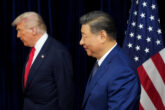November 16, 2017
The critical human element in the machine age of warfare
In 1983, Stanislav Petrov helped to prevent the accidental outbreak of nuclear war by recognizing that a false alarm in Soviet early warning systems was not a real report of an imminent US attack. In retrospect, it was a remarkable call made under enormous stress, based on a guess and gut instinct. If another officer had been in his place that night—an officer who simply trusted the early warning system—there could have been a very different outcome: worldwide thermonuclear war.
As major militaries progress towards the introduction of artificial intelligence (AI) into intelligence, surveillance, and reconnaissance, and even command systems, Petrov’s decision should serve as a potent reminder of the risks of reliance on complex systems in which errors and malfunctions are not only probable, but probably inevitable. Certainly, the use of big data analytics and machine learning can resolve key problems for militaries that are struggling to process a flood of text and numerical data, video, and imagery. The introduction of algorithms to process data at speed and scale could enable a critical advantage in intelligence and command decision-making. Consequently, the US military is seeking to accelerate its integration of big data and machine learning through Project Maven, and the Chinese military is similarly pursuing research and development that leverage these technologies to enable automated data and information fusion, enhance intelligence analysis, and support command decision-making. Russian President Vladimir Putin, meanwhile, has suggested, “Artificial intelligence is the future, not only for Russia, but for all humankind… Whoever becomes the leader in this sphere will become the ruler of the world.”
Read the full op-ed in the Bulletin of the Atomic Scientists.
More from CNAS
-
Transatlantic Security / Technology & National Security
Look Before We Leap on Artificial IntelligenceThis article was originally published on The Dispatch. A debate about the role that artificial intelligence should and will play in society, and how it will affect humanity fo...
By Jon B. Wolfsthal
-
Technology & National Security
Caleb Withers on the Cybersecurity Frontier in the Age of AICaleb Withers, research associate at the Center for a New American Security, joins Kevin Frazier, the AI Innovation and Law Fellow at the University of Texas School of Law and...
By Caleb Withers
-
Technology & National Security
Prepared, Not ParalyzedExecutive Summary The Trump administration has embraced a pro-innovation approach to artificial intelligence (AI) policy. Its AI Action Plan, released July 2025, underscores t...
By Janet Egan, Spencer Michaels & Caleb Withers
-
Indo-Pacific Security / Technology & National Security
Sharper: Tech + ChinaRecent talks between President Donald Trump and Chinese Communist Party General Secretary Xi Jinping placed a spotlight on emerging technologies, from high-end chips to minera...
By Charles Horn & Sevi Silvia




